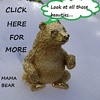Posted 5 years ago
 rhineisfine
rhineisfine
(17 items)
I discovered this charming little brooch in an antique shop in the Cotswolds (England) about 25 years ago. It depicts St. Hubertus, the 8th century patron saint of hunters, mathematicians, opticians, and metalworkers. The shop owners couldn't tell me anything about the brooch's provenance. I've always longed to know more, because it has several unusual features.
First of all, it's only 9/10ths of an inch (2.3 cm) across, so the detail is extremely fine! It's made of .835 silver, an alloy (often called "European silver") containing a little less silver than our .925 sterling. The back is stamped with the initials "F.H." in a tiny impression only 1 mm long.
Religious medals are likelier to be pendants than brooches, round rather than square; and this square brooch with its distinctively cut corners is, in my experience, unique. I don't know who made it or where it's from (Germany, perhaps? - it is decidedly un-English!).























Definitely very high quality workmanship, does not get better than this. The shape is like a 1939 Wrestling pin I have. The silver content is often called coin silver, Beautiful post !~
Thank you for the kind comment, Phil! That's interesting about your wrestling pin - and it could in fact suggest a date for mine, too, if that shape was in fashion for pins and brooches around that time. And I appreciate the explanation of "coin silver". It's so helpful to know the terminology!
This form of maker`s mark is most likely Austria.
If it was officially imported to Britain the sponsor (importer) could not have it assayed because of lower fineness than sterling. Austrian makers produced silver in sterling standard to conform with British import legislation and assaying, so one can assume this brooch was acquired in Austria and brought to Britain.
rhineisfine, Beautiful brooch. :-)
Not to mention an interesting discussion.
It looks like the future saint is deer hunting with a crossbow. Here's only one interesting tidbit from the Wikipedia article about St. Hubertus:
*snip*
Hubertus (German) is honored among sport-hunters as the originator of ethical hunting behavior.
*snip*
https://en.wikipedia.org/wiki/Hubertus
keramikos, thank you for your comment. That's interesting about the ethical hunting behaviour! Yes, the saint-to-be was said to be out hunting when he had a vision of a stag with a crucifix between its antlers, and heard a divine voice instructing him to abandon his dissolute life. I don't think he was told to stop hunting altogether; but recognizing the need to hunt responsibly would, I am sure, have been an improvement.
Ms.CrystalShip, thank you for your sweet feedback. Yes, this medal - or, at least, its shape, plus its being a brooch - is certainly unusual. I bought it when I was on a trip with my parents; and since they are both long gone, this pin reminds me of many happy memories with them. So it is extra precious to me for that reason.
IVAN49, thank you for your helpful comment! Given the history of the Venerable Order of Saint Hubertus, it does make sense that it could come from Austria. However, I was wondering if you could kindly explain what it is about the mark specifically (or anything else) that speaks to an Austrian origin?
Austria introduced in 1867 very precise form of maker marks, i.e. frames (cartouche) to accommodate maker`s initials (e.g. ovals, rectangles etc.). One frame was an oval with both ends cut (like yours mark). None of European countries had similar cartouche, so it must be Austria after 1867.
IVAN49, I really appreciate the explanation - thank you so much! How lovely to know where this is from. I will cherish it even more now. Thank you again.
Thank you for all the research done on this post - I think all the others have said anything more I could say.
Thank you for the nice comment and for the love, RichmondLori!
And thank you all for loving the brooch: kwqd, PhilDMorris, IVAN49, Ms.CrystalShip, Gillian, Brunswick, dav2no1, aura, racer4four, jscott0363, fortapache, vetraio50 and LovelyPat!
St. Eustace, too. Catholics use the White Stag as big symbolism.
In Catholicism and Eastern Orthodox, the white stag was partly responsible for the conversion of the martyr Saint Eustace. Eustace saw a vision of Christ between the stag's antlers and was told that he would suffer for Christ.[3] A similar legend is associated with Saint Hubert.[4]
White Hart Badge of Richard II
The White Hart was the badge of King Richard II of England, who probably derived it from the arms of his mother, Joan "The Fair Maid of Kent", heiress of Edmund of Woodstock. It may also have been a pun on his name, as in "Rich-hart".[5] Richard's White Hart is recumbent and wears a gold crown as a collar, attached to a long gold chain, symbolising both the suffering of Christ and Richard's burden of kingship, both noble and enslaved. It associated Richard's rule with piety and asserted his divine authority. The emblem features prominently in a notable piece of late 14th-century religious art known as Wilton Diptych (National Gallery, London), which is thought to be the earliest authentic contemporary portrait of an English king; in the diptych paintings, Richard II is depicted wearing a gold and enamelled White Hart jewel, and even the angels surrounding the Virgin Mary all wear White Hart badges. On one of the reverse panels, there is a White Hart seated on a bed of rosemary, symbolising remembrance and sorrow.[6]
https://en.wikipedia.org/wiki/White_stag
The Catholic fairy tales are ALWAYS so brutal! I had a book of Saints as a kid, like a fairy tale book. Every single one of them died in some horrid fashion. Yeah - it was illustrated!
St. Eustace:
The 13th century French version of the narrative begins with Placidus (Eustace's name before he was baptized) out hunting. He follows a deer into some woods and becomes separated from the group of hunters; the deer turns towards him. Placidus is then awestruck by a vision where he sees the cross between the antlers of the deer, and in that moment, he is commanded by the voice of God to be baptized along with his family on that very night by the Bishop of Rome. He is baptized and has his name changed to Eustace, and then he receives another vision from a voice warning him of future trials for him and his family. They lose their goods, servants, livestock, and social status. They attempt to travel by boat, but cannot afford the voyage. Eustace and his two sons Agapius and Theopistus are then removed from the boat and separated from Eustace's wife Theopista. They arrive at a river where Eustace has to carry them across one at a time. After successfully taking one to the other side, Eustace attempts to collect the other. However, both of his sons are taken by animals while he is crossing the river: one by a lion and the other by a wolf. Unknown to Eustace, his sons are saved and raised independently.[2]
Fifteen years later
In the French tradition, Eustace then worked for fifteen years as a guard protecting fields until he was approached by two envoys of Roman emperor Trajan who were sent to persuade him to return to Rome and repel an uprising; Eustace complied. There in Rome, he was reinstated his original rank of general, led an army, and coincidentally, achieved victory in the home country of the captain who abducted his wife Theopista. Trading life stories after the battle, two soldiers discover they were the brothers abducted by animals, and overhearing them, Theopista recognizes her husband Eustace. Eustace and his family then return to Rome to celebrate at a victory dinner under the new Roman emperor Hadrian who was less tolerant towards Christians. Following the dinner, Hadrian requested Eustace and his family to make an offering to pagan gods; They refused. Eustace and his family were then thrown in a den of lions, but the lions did not touch them. Eustace and his family were then put into a brazen bull. They died, but their bodies were untouched by the flames.[5]
https://en.wikipedia.org/wiki/Saint_Eustace
@Celeine, thank you for your 2 posts about St. Eustace and for your "loving" my brooch :) The information about the symbolism of the stag was particularly interesting and striking.
Tell me, have you ever heard whether there is an iconographic distinction between St. Eustace and St. Hubert? From everything I've read, the depiction of one can easily be mistaken for the other.
I don't know for sure, of course, which this brooch depicts. However, IVAN49's comments about a likely Austrian origin suggests to me that St. Hubert is more likely, as the Venerable Order of St. Hubertus was especially popular in that country. Indeed, when the Order refused (after the Anschluss) to admit Nazis as members, the Order was banned outright. It is not hard to imagine that to wear the image of St. Hubert might have become a small symbol of defiance. But that is just conjecture, of course.
On a personal note, and speaking as someone sympathetic to wildlife, I always found it a little odd that the vision of the white stag didn't lead to St. Hubert giving up hunting :)
A lot of coins of Europe and canada were made of 800 silver content. This % of silver was much used in silver teapots, bowls, cutlery and trophies. The octagon shape also was used in a lot of medals, money, tokens, and also I have seen a lot of French art deco plaques made in that shape.
PhilDMorris, thank you for that helpful information! I've never really collected silver beyond the costume-jewellery level, so even now I am very much in beginner mode. It's so interesting how silver standards have varied from country to country. When I was a volunteer researcher at a local charity shop, we once got in a Wang Hing shoehorn made of Chinese export silver (90% purity, possibly a little higher in Wang Hing's case). That was fun to research!
George Jenson also used silver to make a lot of jewelry in this shape. I had considered buying some of his pieces. I still love my wrestling pin or medal though !~